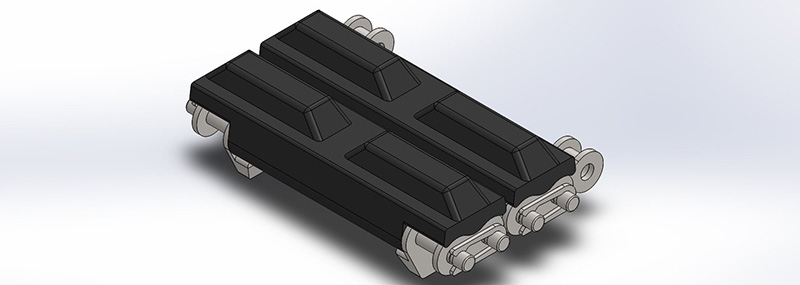There are a lot of robotics platforms out there, and whether for educational use or for robot fightin’ time, two things remain constant: tracks are often the best solution, and there aren’t very many modular track systems that can be used with a variety of designs. There are even fewer that can be built at home. [jupdyke]’s project fixes that. It’s a modular and easy to replicate system for tracked vehicles.
The design for this system of track uses roller chain, chosen because the components of roller chain are mass-produced in incredible quantities, sprockets are available in every imaginable size, and all the parts are available in different materials.
Rolling two chains around a few sprockets isn’t a problem; the hard part of this build is figuring out how to make the actual treads, and then making a lot of them. [jupdyke] is making them by 3D printing a few mold masters and doing a few test prints with silicone and polyurethane rubber. For a one-off project, it’s a lot of work, but if you’re making thousands of tracks, molds are the way to do it.





















cool indeed and I’m very glad to say that this entry at least has a prototype to go along with it.
Dear HaD: Today on your opening Blog page I count four of the seven posts are contest/prize/give-away gimmicks. This is becoming – to say the least – tedious. I have been supporting HaD since the outset, and given that the site has lived and prospered to-date, I feel that earns me the right to comment when I feel your ship is off course. Now is one of those times. Regards, David (p.s. for nostalgia’s sake i hould have typed this comment in all lowercase.)
go to thingiverse and put in “robot” on the search… hundreds of 3D printable tank tracks. Thwy work fine, and work well in ninja flex. Excellent cutting edge news hackaday! Bore…
Nobody has put together an extruded set or injection molded set and crowd funded it yet?
http://ruemohr.org/~ircjunk/images/p1070056.jpg
Shortly after I started trying to make track I realized that its really important to keep the piece count down. I think this struck me after I decided to strip down roller chains and re-assemble it into wider chain for use as tracks, at some point after making a 3d printer I realized that I could get it down to 2 peices per link (yup, avoiding snap-togethor). 2 hours for 9 links, and I can be sleeping while they are made.
Conveyor chain.
“but if you’re making thousands of tracks, molds are the way to do it”
Injection molds, perhaps. RTV molds? Let’s hope we don’t have any wars while we are sill molding our tank tracks!
It looks like he bought a bunch of custom pins to widen the track, but each link would essentially be a master link. Why not go the route of a multispeed bicycle chain and use longer press-fit pins for every link, with no master links at all, OR the way motor cycles and other single-sprocket vehicles (i.e. kids bikes), and have only one master link? The non-master-link pins could simply be plain pins with a slight chamfer on the ends to facilitate pressing.
I guess the advantage of the all-master-link method would be that you wouldn’t need any special tools to press the link pins.
The *tracks* look easy to replicate.
But searching far and wide for a supplier that will sell you unassembled roller chain segments, getting a small run of custom pins machined, and paying over $250 shipping to get segments and pins shipped from China… Kinda detracts from the “easy” aspect of the overall project.
If [jupdyke] has plans to deal with China, stock the components, and sell them to hobbyists in the future with reasonable prices and shipping, that would be easy. Perhaps this is why he didn’t list any of his suppliers.
I wonder about an alternate method [jupdyke] listed as inspiration:
“Another method is to put a bolt through the roller chain to connect to the treads. This is a cheap and easy solution, but now the roller chain cannot be driven by the standard sprockets.”
Assume the bolts are installed on every other chain segment, the entire chain has an even number of segments, and the sprockets have an even number of teeth. This is what his example pictures for this method show, driven with a non-standard (and presumably expensive) sprocket that’s manufactured to lack every other tooth. But I can’t imagine it would be too difficult to take a standard sprocket, and knock out a few teeth with an angle grinder.
I’m using garden track on my robot its wide, but you can build two whole track assemblies for £40 or so